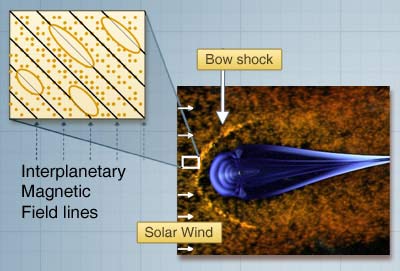Earth Surrounded by Giant Fizzy Bubbles

The space above you is fizzing with activity as bubbles of superhot gas constantly grow and pop around Earth, scientists announced today.
Astronomers found the activity up where Earth's magnetic field meets a constant stream of particles flowing out from the Sun.
While space is commonly called a vacuum, in fact there is gas everywhere, albeit not as dense as the air you breathe.
The newfound bubbles are technically called density holes. In them, gas density is 10 times lower. The gas in the bubbles is 18,000,000 Fahrenheit (10,000,000 Celsius) instead of the 180,000 degrees Fahrenheit of the surrounding hot gas, which is known as plasma [Graphic].
The bubbles were found in data collected by the European Space Agency's Cluster mission, a flotilla of four spacecraft. Researchers first thought they had an instrument glitch when the spacecrafts passed through bubbles.
"Then I looked at the data from all four Cluster spacecraft. These anomalies were being observed simultaneously by all the spacecraft. That's when I believed that they were real," said George Parks, University of California, Berkeley.
The bubbles expand to about 620 miles (1,000 kilometers) and probably last about 10 seconds before bursting and being replaced by the cooler, denser solar wind, Parks and his colleagues say. [Find out why the high temperatures don't fry the spacecraft.]
Get the Space.com Newsletter
Breaking space news, the latest updates on rocket launches, skywatching events and more!
It is not known for sure how the bubbles are created, but the researchers suspect it involves the solar wind colliding with the magnetic field, which forms a boundary called the bow shock. The phenomenon is similar to the wake formed by the front of a boat.
The discovery, detailed in the journal Physics of Plasmas, could help astronomers better understand how this solar wind interacts with the magnetic field.
- Biggest Space Explosion Creates Giant Bubbles
- Exploding Miniature Black Holes: Galaxy May Be Stuffed With Them
- Study of Problematic Space Bubbles Electrified
- Blowing Bubble Seen By Hubble
- Bubble-in-a-Bubble, by Hubble
Join our Space Forums to keep talking space on the latest missions, night sky and more! And if you have a news tip, correction or comment, let us know at: community@space.com.

Rob has been producing internet content since the mid-1990s. He was a writer, editor and Director of Site Operations at Space.com starting in 1999. He served as Managing Editor of LiveScience since its launch in 2004. He then oversaw news operations for the Space.com's then-parent company TechMediaNetwork's growing suite of technology, science and business news sites. Prior to joining the company, Rob was an editor at The Star-Ledger in New Jersey. He has a journalism degree from Humboldt State University in California, is an author and also writes for Medium.
Most Popular

